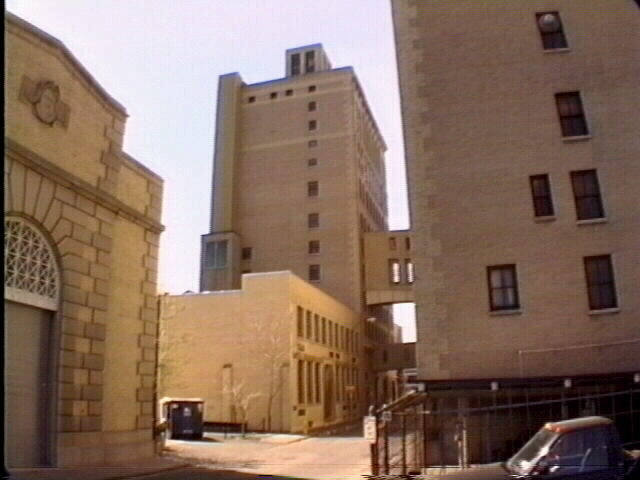
from City of Rochester Property Information
| Eastman School of Music | Sibley Music Library |
 |
| The 1938 Sibley Music Library building is the two-story building
in the middle of the picture from City of Rochester Property Information |
| Pictures of Sibley Music Library | |||||
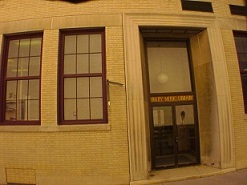 |
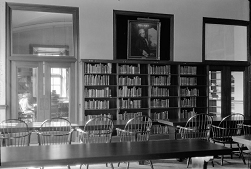 |
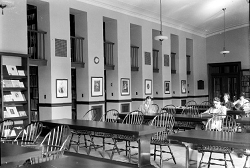 |
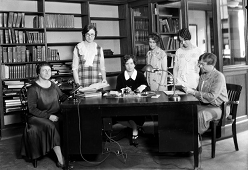 |
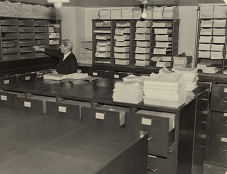 |
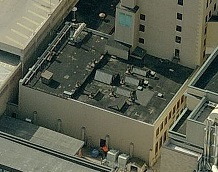 |
The Sibley Music Library was originally established in 1905 in Sibley Hall on the Prince Street Campus. The library was a gift of Hiram Watson Sibley, son of Hiram Sibley, who had donated Sibley Hall to the University in 1874.
The collection was moved in 1922 to a large room at the southeast corner of the first floor corridor of the Eastman School of Music. The library then moved to a new building on the east side of Swan street that opened in 1938.
The library moved to the new Eastman Place building in 1989, which was renamed the Miller Center in 2004.
References
1905 "New Sibley Music
Library Complete," Democrat and Chronicle, January 1, 1905,
Page 19.
In Library in Sibley Hall are over 800 works on Music and Scores.
1921 "Moving Music Library," Democrat and Chronicle, December 30, 1921, Page 16.
[1930] The Sibley musical library in the Eastman School of Music
1937 "Music Library to Move Jan. 1," The Campus, December 10, 1937, Page 1.
1938 "U.R. Dedicates Music Library," Democrat and Chronicle, February 11, 1936, Page 21.
1946 "The Sibley Music Library," by Barbara Duncan, University of Rochester Library Bulletin 1(2) (February 1946)
1958 "Sibley Music Library," Rochester Review 20(2):9 (November 1958)
1970 The
History of the University of Rochester Libraries--120 Years,
by Catherine D. Hayes
Chapter 8 - The Sibley Music Library
At the beginning of the twentieth century Hiram W. Sibley, son of the
University's early benefactor, started a collection of music for the
benefit of music lovers of the city as well as for the college. The wisdom
of such a collection was first suggested to Sibley by Elbert Newton, a
prominent Rochester musician and bibliophile. Newton had a keen interest
in "modern" music, literature, and art, and thus, when Sibley provided him
with the money, he went to New York and bought widely of the works of then
little known composers such as Debussy, Ravel, Stravinsky, Rachmaninoff,
Sibelius, Wolf, Reger, Malipiero, and Respighi. He also purchased the
works of the better-known Classical and Romantic writers. Later, in 1918,
Sibley provided more funds and Newton added another 6,000 volumes of books
and music to the collection. All of these were deposited in the Sibley
library on the Prince Street Campus. This extensive buying increased the
collection to some 9,000 volumes by the time George Eastman established a
music school in the early 1920's.
The first plans for a music school did not include provisions for a
library, but before school construction was completed Eastman and Sibley
agreed to cooperate in their two ventures and space was allotted in the
new building for the library collection. In 1922 Sibley's collection was
moved from the University campus to the Eastman School of Music.
This new arrangement was an incentive to Sibley to accelerate his
purchases, and from the early 1920's until his death in 1932 he
contributed approximately $75,000 for these purchases. In the first few
years of the twenties he purchased a number of important collections en
bloc. The first was the library of Otto Sonneck, for two decades the
leading musicologist in the United States. This contained many of the
definitive scholarly editions of the great composers, and considerable
bibliographical and critical material. There was the Kreiner collection of
Russian folk and liturgical music, with many historical and critical
works, largely European, relating to them. Then came the Fleming
collection of rare and costly books on the history of musical instruments.
A major acquisition was the library of Arthur Pougin, French musical
critic, biographer, and collector, of more than 3,000 volumes. Then came
the folklore collection of Henry E. Krehbiel, and the original manuscript
score of Sir Henry Bishop's "Clari; or the Maid of Milan" which first gave
"Home, Sweet Home" to the world.
The music library was provided with its own building on Swan Street in
1937, having by that time about 37,500 volumes of books and music. By the
1960's the Sibley Music Library had 120,000 volumes; and some 25,000
uncatalogued songs, sheet music, and pamphlets, and a significant
collection of recordings, microfilms, microcards, and manuscripts. It now
contains a quarter-million items.
The library, which is undoubtedly one of the finest in the country, has
developed in line with the growth of the music school's curriculum. The
development may be seen in the acquisition of books in related fields, in
general philosophy, as well as in aesthetics, in poetry, and in the fine
arts. It is particularly strong in works of musical theory, in the
complete and authoritative editions of the great composers, in historical
anthologies and incunabula. Among the anthologies are the Denkmaler der
Tonkunst in Osterreich, the Denkmider Deutscher Tonkimst, the Paleographie
Musicale, the Lira Sacro-Hispana, the Mornonenta Musicale Byzantinae. Its
incunabula in the field of theory include works by Gafurius, Keinspeck,
and Le Fevre. Other rare treatises are works by Hermann Finck, Adrian
Coclicus, Cerone, Pietro Aaron, Vicenzo Galilei, G. B. Doni, Boethius,
Praetorius, Prasberg, Ramos de Pareja, Salinas, Wollick, Zarlino,
Agricola, Cochlaeus, Fogliani, Glareanus, Thomas Morley, Thomas Mace,
Christopher Simpson, John Playford Rameau, and Charles Butler.
In 1929 the library acquired, from the famous library of Dr. Werner
Wolffheim, the eleventh century Reichenau Codex, which contains musical
treatises by Hermannus Contractus, William of Hirsau, Bernon, and Frutolf
of Michelsberg, as well as treatises on other arts of the Middle Ages. It
also possesses what is now known as the Rochester-Adinont Codex, a twelfth
century codex from the monastery of Admont in Austria, which consists of
the works by Guido, Aribo the Scholar, William of Bernon, and Hermannus
Contractus.
The library also is rich in its manuscript collection, some of it
beautifully illuminated. It includes leaves from the medieval collection
of Oskar Fleischer with his descriptive notes. Among its holograph scores
are works by Purcell, Beethoven, Mozart, Liszt, Brahms, Rubinstein,
Schumann, Faure, Krenek, as well as the Americans Chadwick, Foote, Hill,
MacDowell, Mason, Copland, Harris, Rogers, Thompson, Antheil, Bacon,
White, Porter, and Hanson. There also are comprehensive collections of
orchestral scores, chamber music, instrumental music, dramatic music, and
the history and theory of music.
1977 "The Sibley Music Library of the Eastman School of Music, University of Rochester," by Ruth Watanabe, Notes 33(4)-782-802 (June 1977)
1977 History
of the University of Rochester, 1850-1962, by Arthur J.
May. Expanded edition with notes
Chapter 18, The Birth of a Music Center
In the meantime, praiseworthy progress had been made in equipping the
school with one of the largest, finest, most comprehensive musical
libraries in the United States. Collections of books on music and musical
manuscripts acquired by Hiram W. Sibley of Rochester formed the solid
nucleus of the library. A lover of music himself, Sibley in 1904 had been
persuaded to collect musical works by Elbert Newton, organist of the
Central Presbyterian Church, who acted as purchasing agent. In the
capacity of "angel," Sibley wished a "working" collection of books without
"frills and curiosities," and in the light of that, directive Newton
concentrated on buying standard titles and a considerable quantity of
"modern" music. The holdings were deposited in the Sibley Library, built
by the donor's father, on the Prince Street Campus; Sibley paid the salary
of a curator who issued a catalogue of the collection and supplements.
Although any responsible Rochesterian might borrow books, circulation was
not large, but used freely by students in the nearby Institute of Musical
Art.
In January of 1922 the Sibley collection was transferred to the music
center and installed in a large room at the southeast corner of the first
floor corridor of the School. Known as the Sibley Musical Library, the
growing collections remained there until the separate library building
became available (1937). On a wall of the reading room a portrait of the
benefactor was hung (along the corridor a likeness of Wolfgang A. Mozart
looked down benignly on the passing scene), and a bronze tablet just
inside the entrance read: "This Musical Library given by Hiram W. Sibley
is for the use of all music lovers in Rochester."
Chapter 28, Music and Medicine in the 1930's
Expansion of book collections and increase in the student body caused
insufferable congestion in the temporary library quarters. Consequently,
in 1937, a music library building, believed to be the first of its kind in
America, was erected on the east side of Swan Street, and the former
library facility was refitted as a relaxation lounge for students and
teachers. On February 10, 1938, the new structure was formally dedicated.
The book circulation department, card catalogues, and space for reading
occupied the first level, while on the second floor seminar and listening
rooms were provided. According to the original blueprints, book stacks
would rise to ten levels with cubicles for study along the eastern wall;
however, only four stacks were in fact built and plans for an elevator,
alas, were not carried out.
Chapter 39, The Eastman School--The Postwar Years
Another possibility, not followed up, was to retain Hutchison House as a
student union and make Cutler into an Eastman School graduate center.
Sibley Music Library would have been housed in the great hall, and the
rest of the building devoted to graduate work and seminars; undergraduate
work, applied music, and practice rooms, would have remained downtown.
1980 "The
Sibley Music Library: A World Collection," by Ruth T. Watanabe, from
University of Rochester Library Bulletin 33 (1980)
This paper is a revised and enlarged version of an article published in
Notes, the quarterly journal of the Music Library Association, Vol. 33,
No. 4, June 1977, pp. 783-502.
1985 "Music Library likes proposed new home," Democrat and Chronicle, November 13, 1985, Page 5B. | part 2 |
1989 "A
Modern Vision of Eastman Place," Democrat and Chronicle, May
15, 1985, Page 3B. | part
2 |
Sibley Music Library opens today; it's hidden jewel of new building.
© 2021 Morris A. Pierce